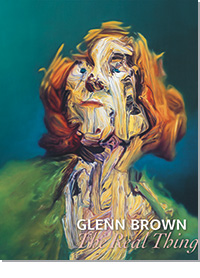
|
|
|||
Glenn Brown: The Real Thing English/German |
“In all of my work, really, the subject is paint. I like the viscosity, the color, the translucency and just the material gooiness of paint and that is quite an abstract subject to have. So that’s why I loosely bring in elements of the human body, just to embellish my paintings with paint. It seems to be a completely back-to-front way of making a painting, but it somehow works for me.” —Glenn Brown
In his double exhibition at the Sprengel Museum and the Landesmuseum Hannover, Glenn Brown showcases a retrospective selection of his own works since 1995 and confronts them with a selection of favorite paintings from the collections of both museums. The hanging is not organized chronologically according to eras and schools, but focuses on parallels in subject matter: the perishable form, the exposed body, the human image, characterized through brushwork, surface, and materiality. In this way, Brown brings continuities and contrasts from 500 years of painting history into a contemporary dialogue, which is also part of each of his own paintings since the history, topics, and styles of European imagery are always present when he quotes motifs from old masters or science fiction illustrators, recomposes them, and creates his own worlds from brush strokes rendered in minutely fine painting. The book condenses the concept of the exhibition in pointed juxtapositions of paintings and thus opens up a dialogue with history from today’s perspective that restores the old masters’ original immediacy and unruliness.
WHERE THE EYE WANTS TO GO Part of the work is about how people look. Not about how a certain character comes out in an individual, but more about what elements are at play in a human being, what energy can be found, what contradictions come together. What forces shape our appearance? In many of Brown’s works, it seems that nature has contributed or even taken the lead in defining the looks. And nature is wild, not there to flatter us, no matter how hard we try to be in control of our image. Including this understanding in the depiction of people seems to be essential to Brown’s works – to show people not as perfect but as life has shaped them. And yet to show that with precision and perfection. Brown might not express himself in the painting, but his view on life is nonetheless part of the work. He is present in the paintings, not by putting out an existential message or phrasing a subjective voice, but through the way he paints. In the way he sees things and builds up the painting as a careful, meticulous construction. “I like things to be finished. I have an acute sense of detail. I am expressing that aspect of myself.” Or, with irony: “I’m anal retentive, and you can see that in my paintings.” Each painting is rooted in the tradition of art history, in the work of 17th- or 18th-century painters, or of his contemporaries or sometimes of himself. The word “traditional” is often used in a condescending way, as in opposition to innovative or contemporary. But it just means that Brown works in a centuries-old lineage. There is no point in hiding the fact that painting develops in dialogue with other painters. The references go back to baroque and mannerist painting. But then—shift of time—there is also an attraction to a wholly different, more futuristic type of imagery. Science fiction springs to mind; some paintings evoke a fantasy landscape. Here Brown’s biography comes in, with the popular imagery that surrounded him growing up, maybe the posters from his childhood room or the ones seen at movie theaters. Looking at Brown’s works, especially those from recent years where the brushwork grows more intense, you wonder if the artist considered a path through each of them, in terms of where to start looking, where to continue and where to leave the painting. I sense that he conceived his work rather purposefully in such a way that it is hard to leave—for instance, by making the viewer move backwards and forwards between wanting to see the overall picture and then discovering a color accent that needs closer attention. Seeing very fine details and, from a distance, the overall image melting together. Composition is also orchestration of attention, anticipating how and where the eye moves. Color is not just used in a subjective or intuitive sense; it has mechanisms which are deliberately used, such as a warm-cold contrast or the tendency of the eye to look for a complementary color…
... In collaboration with Landesmuseum Hannover und Sprengel Museum Hannover |